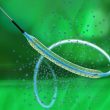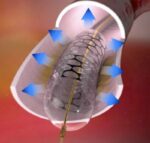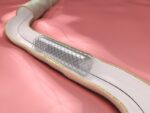Original Title: Drug-eluting balloon versus second-generation drug-eluting stent for the treatment of restenotic lesions involving coronary bifurcations. Reference: Toru Naganuma et al. EuroIntervention 2016;11:989-995 Courtesy of del Dr. Santiago F. Coroleu. PCI involving in-stent restenosis (ISR), especially in coronary bifurcations, is associated with high rates of recurrent restenosis and the need for new revascularization. Although drug...
DAPT TRIAL: double antiaggregation remains controversial
Article This multicenter randomized control study with placebo was designed to determine the risks and benefits of double antiaggregation for longer than 12 months post DES stenting. 9961 patients were randomized to continue on placebo or thienopyridine after 12 months. Thienopyridine reduces the incidence of in-stent thrombosis (0.4% vs 1.4%; p<0,001) and cardiovascular events (4.3%...
CTO-IVUS: IVUS clinical impact in total occlusions with 2nd generation DES
While the use of intravascular ultrasound (IVUS) during coronary intervention proved useful in multiple studies, there is limited evidence in the literature regarding its use in specifically in chronic total occlusions. The IVUS may help guide in recognizing the true lumen and better distal positioning, better coverage of stent, an optimal apposition and expansion, diagnose...
TRYTON: dedicated stent for bifurcations not inferior than the provisional technic
This study compared the clinical and angiographic results of the use of the provisional stent technique versus the 2 stents technique (TRYTON device at the side branch) in true bifurcations. The study with non-inferiority design, randomized 704 patients in total to drug-eluting stent in the main branch plus the TRYTON device in the side branch...
ETAP: Endovascular treatment of atherosclerotic popliteal artery lesions: a prospective, multi-center, randomized study.
Introduction: The popliteal artery is a vessel considered unfavorable for the implantation of a stent due to the forces exerted in the popliteal fossa during limb flexion, which could fracture the stent antlers and compromise the outcome of the procedure at long-term. So far, stents used in popliteal lesions have not been compared with balloon...
RENAL DES: reduction of restenosis in patients with kidney failure
Coronary angioplasty in patients with kidney failure is associated with an increased occurrence of events. This study compared the efficacy of preventing clinical restenosis using an everolimus-eluting stent versus a conventional stent, both implanted in the same patient with lesions in more than one vessel and suffering from kidney failure. The primary endpoint was target...
CENTURY: new clinical results of sirolimus-eluting degradable polymer stent
This new stent is a sirolimus-eluting low-profile cobalt chrome platform (80 µm) with a rapid resorption polymer (3 months). Theoretically, it presents less risk of inflammation of the vessel due to the kinetics of drug elution and polymer degradation. The objective of this study was to test the safety and efficacy of the new device....
Angioplasty using a drug eluting balloon in the superficial femoral artery
Original title: Drug-Coated Balloon Versus Standard Percutaneous Transluminal Angioplasty for the Treatment of Superficial Femoral and Popliteal Peripheral Artery Disease 12-Month Results From the IN.PACT SFA Randomized Trial. Reference: Gunnar Tepe et al. Circulation. 2015;131:495-502. This interesting study randomly selected 331 patients with intermittent claudication or ischemic rest pain due to stenosis of the superficial femoral artery or...
Zotarolimus eluting stent with one month of dual antiplatelet therapy
Original title: Zotarolimus-Eluting Versus Bare-Metal Stents in Uncertain Drug-Eluting Stent Candidates. Reference: Marco Valgimigli et al. J Am Coll Cardiol. 2015;65(8):805-815. The use of drug eluting stents (DES) in patients at high risk of bleeding or thrombosis has not been studied prospectively. Data on patients at high risk of bleeding and low restenosis are limited. This study compared...
Safety and efficacy of DES in saphenous vein bypass graft PCI
Original title: Safety and effectiveness of drug-eluting versus bare-metal stents in saphenous vein bypass graft percutaneous coronary interventions: insights from the Veterans Affairs CART program. Reference: Aggarwal V et al. J Am Coll Cardiol. 2014;64:1825-1836. This study retrospectively evaluated 2471 receiving after saphenous vein graft (SVG) PCI between October and September 2011. Outcomes were compared using propensity...








